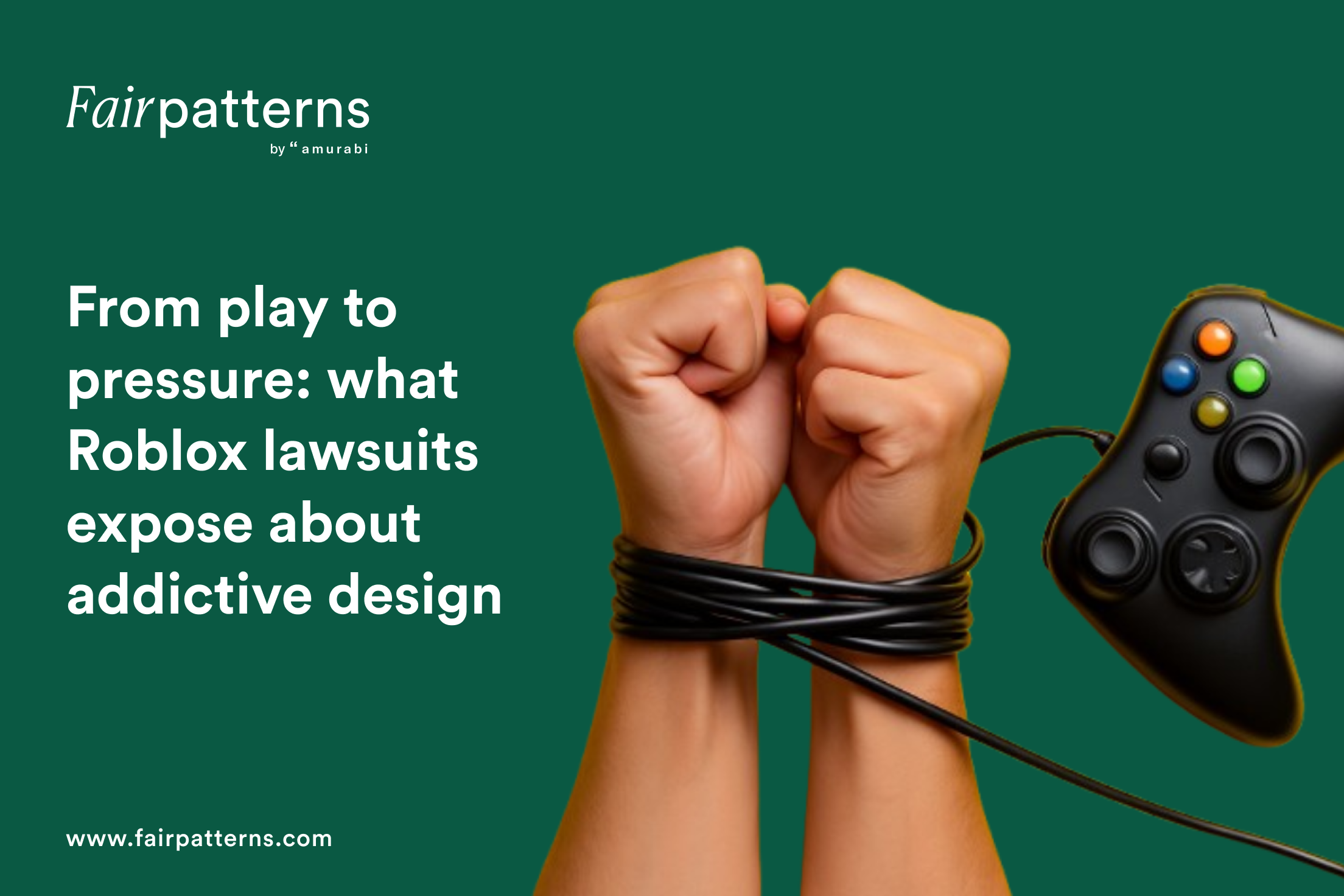From Play to Pressure: What Roblox Lawsuits Expose About Addictive Design

Addiction by design:
In 2024, over 3.3 billion people played video games. For children and teenagers, gaming is more than entertainment; it’s a primary digital space shaped by fast-moving, immersive design. As the industry grows, with projections reaching over $691 billion by 2029, the risks grow alongside it.
The industry is now facing growing scrutiny. Some experts have described video game addiction as the “new drug” of the digital age. At the center of the concern is not just screen time. It is also about how specific design choices, such as randomized rewards, behavioral triggers, and time-limited offers, encourage prolonged use and repeated spending.
Regulators and courts now recognize these design practices as legal risks, not just business decisions.
On July 10, 2025, a California judge added 18 lawsuits involving Roblox and other major platforms to a coordinated legal proceeding on video game addiction. The cases accuse companies of designing their products to exploit young users, using psychological triggers that encourage compulsive use and repeated purchases.
The legal question is no longer whether these designs are effective. It is whether they are exploitative, and whether companies can be held responsible for the impact those designs have on young users.
The legal case against addictive design:
Roblox, a user-generated platform popular with children and teens, is at the center of a growing set of lawsuits in California. Other companies named include Epic Games, Microsoft, Nintendo, Apple, Google, and Sony.
Parents allege these platforms were intentionally designed to be addictive, especially for minors. The lawsuits highlight design systems that go beyond entertainment and into behavioral manipulation, including:
- Loot boxes and randomized rewards
- Cosmetic microtransactions
- Behavioral tracking and personalization
- Interface features that encourage compulsive use
The lawsuits argue these choices were deliberate and profit-driven and a California judge approved the coordination of 18 new lawsuits under Judicial Council Coordination Proceeding No. 5363, streamlining discovery across counties. A case management conference is set for August 16, with a joint litigation roadmap due by August 22.
According to about lawsuits complaints describe children becoming emotionally withdrawn, spending over $350 a month, and showing signs of anxiety, depression, and anger. Financial loss is a recurring issue, tied to repeated in-game purchases made without full awareness.
A global call for design compliance:
Parents leading the suits claim that these design systems weren’t accidental. They were built to keep children playing, spending, and returning. As courts begin to examine that system, companies across the gaming industry are facing serious compliance risks.
Regulatory action is no longer optional. In the United States, Epic Games agreed to pay $245 million in FTC refunds and $200 million in penalties after federal authorities found that in-game mechanics had misled players, many of them minors, into unintended purchases. In the EU, platforms are now under investigation for possible violations of the Digital Services Act, which allows for major financial penalties tied to manipulative systems.
Minors are a clear focus of the EU’s proposed Digital Fairness Act. The law is being shaped to address how platforms and games use psychological techniques and algorithmic systems to influence behavior, especially among younger users.
For designers and developers, the signal is clear. The way games are built is now a legal and ethical issue. Waiting is no longer an option. Design teams must start treating compliance, fairness, and user protection as part of the product itself, not as an afterthought.
What once passed as engagement is now being defined as risk. In today’s digital environment, engagement cannot be forced. It must be earned.
From legal risk to responsible design: FairPatterns’ role
At Fairpatterns, we help companies detect privacy dark patterns and redesign manipulative UX before it becomes a legal risk. Our AI-powered solution turns complex, unclear flows into transparent, trust-first experiences.
Our tool helps you:
- Detect harmful patterns across any taxonomy
- Replace them with tested, compliant designs in plain language
- Prevent future risks by supporting legal-safe design at the mockup stage.
We don’t just help you comply. We help you design for trust.
Want to future-proof your platform for fairness? Connect with us:https://www.fairpatterns.com/contact-us
💫 Regain your freedom online.
References :
Duarte, F. (2025, 5 juin). How many gamers are there ? (New 2025 statistics). Exploding Topics. https://explodingtopics.com/blog/number-of-gamers
Jackson, I., & Jackson, I. (2024, 28 mars). Video Game Addiction Lawsuits Seek Damages From Microsoft, Google, Sony and Other Developers. AboutLawsuits.com. https://www.aboutlawsuits.com/video-game-addiction-lawsuits-developers/
Writer, S., & Adams, M. (2025, 24 juillet). Roblox Addiction Lawsuits To Be Coordinated With Other Video Game Claims in California JCCP. AboutLawsuits.com. https://www.aboutlawsuits.com/roblox-addiction-lawsuits-coordinated-video-game-claims-california-jccp/
















































